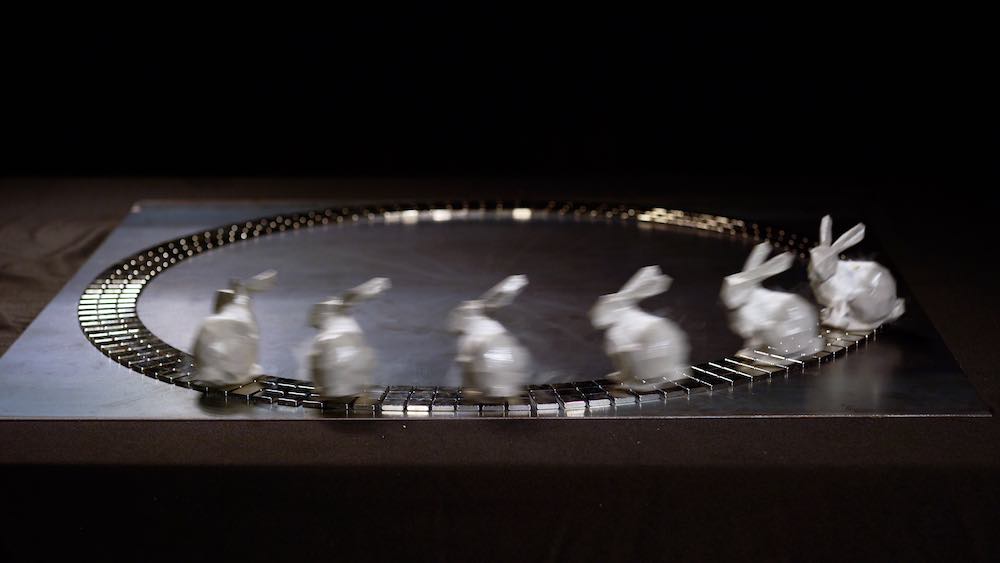
LeviFab is a technology that uses superconducting levitation to hold an object at a fixed position or move it as it levitates in air. Objects can be levitated irrespective of their shapes because the optimal internal structure of the objects is designed and printed using a 3D printer. One can easily imagine the levitation of a highly symmetrical object like a globe. However, in case of an asymmetric object, such as a model of a rabbit, without appropriate measures, the balance is lost and results in a slanted posture. Before printing by a 3D printer, the object can be made not to lose balance by calculating the center of gravity at an appropriate position through adjustments to the internal structure. Although it tends to be unstable when magnetic repulsion is utilized, the flux pinning phenomenon helps prevent lateral slide to realize stable levitation in superconducting levitation. It is possible to move an object without touching it by manipulating only the magnetic field. Moreover, within the objects, there are chambers for liquid nitrogen to cool the superconducting material below -100 ℃. The interior of the object is processed considering not only the center of gravity, but also the superconductivity by incorporating the appropriate thermal insulation. Accordingly, even though the temperature is very low near the center of the object, towards the outer surface, the temperature is preserved closer to room temperature. This way, even if children, out of curiosity, happen to touch the object, there is no risk of injury to the skin. Moreover, after publishing a paper on LeviFab, we have also commenced a project for development of magnetic levitation using permanent magnets instead of superconducting materials. This saves the trouble of replenishing liquid nitrogen, thus enabling long-term exhibition.
< Case >
■ Case 1.
You want to exhibit the model of a product for promotion by making it float in air in harmony with the design of the entire space. You also want to enable lighting freely from all 360° directions on the floating model.
■ Case 2.
You want to develop a diagnostic device for insertion into the human body, which does not have its own power drive, like a capsule endoscope. Instead of letting it move naturally within the body, you are looking for a mechanism that allows it to be freely moved from outside the body.
■ Case 3.
It is not possible to place an object on a desk and keep it fixed in the microgravity environment inside a spaceship. You are looking for ways to move an object without moving it away from the desk by using magnetic force instead of gravity.
< Theory >
■ Levitation using two effects of superconductors
Instead of controlling the magnetic field distribution, an approach is used in which the object to be levitated is embedded with superconductors. The object levitates due to the Meissner effect of superconductors when the object is cooled internally via the injection of liquid nitrogen. Moreover, stable levitation is made possible by the flux pinning effect.
■ Optimization of 3D model
An object may lose its balance if the superconductor is just embedded without any other considerations. Additionally, it is necessary that appropriate thermal insulation be applied so that the outside surface is not cooled, even if the interior of the object is cooled below -100 ℃. Then, at the time of embedding the superconductor and the thermal insulation case, the position of the center of gravity is calculated to optimize the internal structure of the object, which is then printed in a 3D printer.
■ Main accomplishments
[Conference] SIGGRAPH 2017, Studio, article no. 5, Los Angeles, California (USA), July 30 - August 3, 2017.
[Exhibition] Digital Content EXPO, Miraikan - The National Museum of Emerging Science and Innovation, October 28, 2017.
[Media] GIZMODO Japan, September 4, 2017.